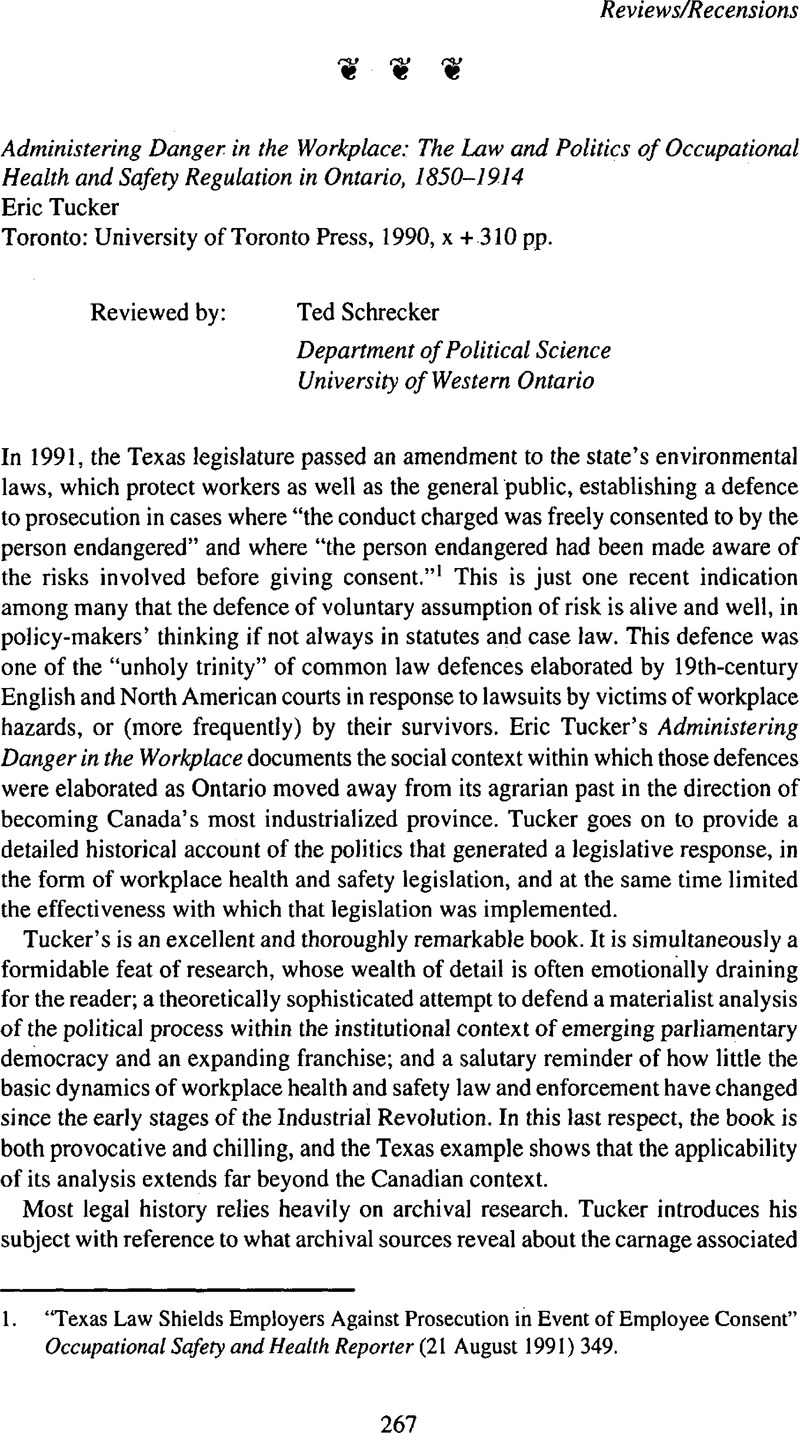No CrossRef data available.
Published online by Cambridge University Press: 18 July 2014

1. “Texas Law Shields Employers Against Prosecution in Event of Employee Consent” Occupational Safety and Health Reporter (21 August 1991) 349Google Scholar.
2. The anecdote of the worker who sleepwalked to his death suggests just how pernicious the decontextualized application of this doctrine of contributory negligence as a bar to recovery of damages can be in practice.
3. In doing so, Tucker uses to great effect Marc Galanter's oft-neglected schematic approach to analyzing the limits to social change imposed by the legal system. See Galanter, M., “Why the ‘Haves’ Come Out Ahead: Speculations on the Limits to Legal Change” (1974) 9 Law and Society Rev. 95CrossRefGoogle Scholar.
4. In Powers of Theory (Cambridge: Cambridge University Press, 1985) at 427–43CrossRefGoogle Scholar.
5. Women were, of course, disenfranchised at this point in Canadian history, and indeed for some decades afterward, meaning that “their needs were defined by men as was the protection they received” (p. 136).
6. Law Reform Commission of Canada, Workplace Pollution (Working Paper 53) (Ottawa: Supply and Services Canada, 1986) at 66–69Google Scholar. (The reviewer acted as principal consultant to this study.)
7. Realizing this characteristic of the 1884 legislation, both the Canadian Manufacturers' Association and the Toronto Trades and Labour Congress engaged in intensive lobbying around the appointment of inspectors following its proclamation (pp. 138–44). On the dimensions of the inspectorate's discretion in contemporary occupational health and safety policy, see Law Reform Commission of Canada, ibid. at 51–54.
8. Interestingly, 31 of the 35 charges were laid by a single inspector; of the two assigned to industrialized southern Ontario, he was the one with a labor background.
9. The 1884 legislation covered only manufacturing establishments, and thus established a pattern of separate regulatory and enforcement regimes for the province's resource and construction industries that persisted for the next nine decades.
10. For documentation, see Law Reform Commission of Canada, supra note 6 at 59–63.
11. Elgie, Hon. R., Standing Committee on Social Development, “Estimates, Ministry of Labour” in Legislature of Ontario Debates (14 December 1981) at sec. 1000Google Scholar.
12. It might be the case, for instance, that even doubling the number of inspectors would make a major difference in terms of the frequency with which high-risk workplaces could be inspected.
13. See Novek, J. et al. , “Mechanization, the Labour Process, and Injury Risks in the Canadian Meat Packing Industry” (1990) 20 Int. J. of Health Services 281CrossRefGoogle ScholarPubMed; Novek, J., “The Labour Process and Workplace Injuries in the Canadian Meat Packing Industry” (1992) 29 Can. Rev. of Soc. and Anth. 17Google Scholar.
14. Faludi, S., Backlash: The Undeclared War Against American Women (New York: Doubleday Anchor, 1991) at 437–53Google Scholar; Johnston, J. D. et al. , “Reproductive and Developmental Hazards and Employment Policies” (1992) 49 British J. of Industrial Med. 85Google ScholarPubMed; Levitsky, M., “Protecting Workers From Reproductive Hazards” (1986) 1 C.J.W.L. 488Google ScholarPubMed.
15. Sass, R., “A Critique: Canadian Public Policy in Workplace Health and Safety” [1991] 2:2New Solutions 41Google Scholar.
16. Tucker, E., “The Determination of Occupational Health and Safety Standards in Ontario, 1860–1982: From the Market to Politics to … ?” (1983) 29 McGill L.J. 260Google Scholar; see particularly at 290–309.